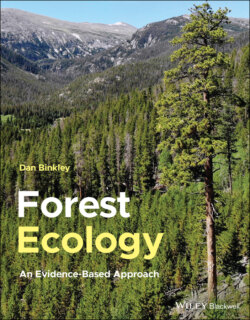Читать книгу Forest Ecology - Dan Binkley - Страница 26
The Coweeta Forests Aren't the Same as Two Centuries Ago
ОглавлениеForests with large, old trees may give an impression of an unchanging system that seem to be stable for decades and centuries. Some temperate forests may fit this image, but most are quite dynamic. If we could visit a forest before and after 50 years of changes occurred, we would likely find that many of the small trees had died (perhaps replaced by others), along with some of the medium‐ and large‐size trees. The overall size of the forest, in terms of height or mass of wood in living trees, may have increased, but typically this increase in the size of larger trees comes in part at the expense of smaller trees that died.
Forests also change more rapidly, as a result of rapid events that alter the typical year‐to‐year progression of changes. The forests at Coweeta experienced massive changes in the past two centuries (Figure 1.8) as a result of direct human impacts and unintended, indirect impacts.
The most noticeable change in the forests in the Coweeta Basin is the loss of the formerly dominant tree species, American chestnut. Long‐lived, large chestnut trees were the most notable part of the forest in 1900. About half the trees in the forest were chestnuts, and chestnuts comprised about half of the forest biomass. An exotic fungal disease from Asia, chestnut blight, killed almost all the mature chestnuts in forests of eastern North America within a few decades. Not all the mature trees were killed outright, as the fungus creates a canker on the stem that topples the tree. Surviving root systems continue to send up hopeful shoots, but these also form cankers when the stems are few meters tall.
What did the demise of chestnut mean for the forest? Given that competition is so important in the interactions among trees, the loss of chestnut led to a dramatic increase in the biomass of other species, particularly oaks, red maple, and tulip poplar. These species responded not by increasing the number of trees in the forest, but with accelerated growth of the already‐present stems.
FIGURE 1.8 Forest composition in the Coweeta Basin in 1935 and in 1990. The total density of trees (left) declined from 3000 trees ha−1 to 1200 trees ha −1, while basal area (right) increased slightly from 27 to 28 m2 ha−1. The decline in tree density is a common feature of growing forests; as dominant trees increase in size, many smaller trees die. However, the trend in this forest was largely influenced by the drastic decline of chestnut. This formerly dominant species was decimated by the exotic chestnut blight disease.
Source: Data from Elliott 2008.
Another major event reshaped parts of the forests of Coweeta after the vegetation survey in 1990 summarized in Figure 1.8. Before this time, eastern hemlock was a major tree species in wetter locations, such as coves and valley bottoms. The hemlock woolly adelgid is an exotic, invasive insect that has killed most of the eastern hemlocks across much of eastern North America. About half the hemlocks died within the first 5 years of the adelgid's arrival (Ford et al. 2012), with 90% or more dead after 15 years (Ford et al. 2012; Abella 2018). The loss of large hemlocks led to drops in the number of trees in the forests by about half, and long‐term changes may include expansion of both trees of other species and understory woody plants (such as rhododendrons).
Continuing back in time, the most notable event of the nineteenth century was the extinction of the passenger pigeon. This large (30 cm) bird was a major consumer of large tree nuts, including acorns, beechnuts, and chestnuts (Halliday 1980; Johnson et al. 2010). Huge flocks contained tens of thousands (perhaps even millions) of birds, with large impacts on dispersal of tree seeds and nutrient cycling (with concentrated feces beneath favored roost and nest trees). Passenger pigeons were the most dominant species of bird in eastern North America, and perhaps the most numerous bird species in the world. Over the course of a few decades, this species spiraled to extinction as a result of massive hunting, and perhaps the effects of changing forest cover and even exotic diseases. How did the forests change in the absence of passenger pigeons? This important question is easily asked, but probably cannot be answered without stronger historical records.
Two other human‐related events marked the 1800s in the Coweeta Basin. The second half of the century saw Euroamerican settlers occupying the land. Their major impacts included some logging, agricultural cropping on a few hundred hectares, widespread grazing of pigs and cattle, and hunting of wildlife for food. The prior inhabitants were Cherokee Indians, forcibly removed in the 1830s. Cherokee influences on the forests included some agriculture (maize, squash, and beans), extensive hunting (primarily deer, turkeys, and bears); food collection (including tree nuts); and frequent use of fire to clear the forest understory (Van Derwarker and Detwiler 2000; Gragson and Bolstad 2006).
